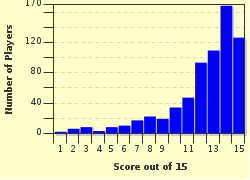Quiz Answer Key and Fun Facts
1. A pioneer of instrument flying who organized and led one of the first counter-attacks on the Japanese Empire in a daring aerial raid in April, 1942.
2. This promising young West Point officer was so skilled in his duties that he "leaped" to the position of Supreme Commander, European Theater of Operations, distinguishing his leadership abilities during the D-Day landings and the Battle of the Bulge.
3. This Austrian-born German "stormed" to power in the 1930s making Fascism the only choice for Germany. He also discouraged the use of tobacco and alcohol and passionately opposed animal testing.
4. This Prime Minister of the United Kingdom from 1940 to 1945 was known for his motivating and inspiring speeches. During the Battle of Britain (1940) he said, "Never in the field of human conflict has so much been owed by so many to so few."
5. This U.S. Army officer headed the Office of Strategic Services (OSS) beginning in 1942. He would eventually be promoted to Major General, over-seeing successful espionage and sabatoge operations in Europe and selected parts of Asia.
6. This French general came to lead the Free French Forces in World War II, later becoming the President of the Provisional Government of the French Republic shortly after the Liberation of Paris in 1944.
7. This top-ranking American general had already enjoyed a full military career before the Japanese attack on Pearl Harbor. As Allied Commander of the Philippines, he escaped the initial Japanese onslaught and evaded capture. When he left the Phillipine Islands he vowed to the world, "I shall return!"
8. This obese German officer became Marshal of the Luftwaffe in 1938. He was Hitler's designated successor during the Second World War and tried at Nuremburg in the wake of the German defeat and sentenced to death.
9. This Vice Admiral was underway on the USS Enterprise during the attack on Pearl Harbor. He later supplied the carrier USS Hornet for the Doolittle Raid, and contributed to victories at Guadalcanal, the Solomon Islands, Bougainville, Leyte, and Luzon. He ended the war as a five-star Admiral and witnessed the Japanese surrender aboard the USS Missouri, his flagship, on September 2, 1945.
10. This British Army Field Marshal assumed command of the British Eighth Army during the North African Campaign, defeating the Germans in the first decisive allied victory of the war at the Battle of El Alamein in 1942. He went on to great success in the Second World War, though his brainchild, Operation Market Garden, was less successful in 1944.
11. This aspiring Italian dictator marched on Rome with his Blackshirt allies, the National Fascist Party, in 1922, which brought him to power. Owing to his past experience as a journalist, his use of propaganda was key to maintaining his control over the Italian people. The people eventually had enough, and on April 28th, 1945 he was executed with his mistress.
12. This colorful and dashing U.S. Army General rose to fame and success in North Africa and Sicily. Though a "slapping incident" nearly threatened his career, he restored his reputation during Operation Cobra in France, 1944. His Third Army advanced on the heels of the Germans until a fuel shortage cut short their momentum.
13. Known as the "Desert Fox," this German General was a rising star in World War 2. He led the famed Afrika-Korps to initial successes in the North African Campaign and was responsible for the construction and defense of the Atlantic Wall on the English Channel coast of France.
14. This 33rd President of the United States took the oath of office upon the death of Franklin Delano Roosevelt in April, 1945. He hailed from Missouri and had much to contend with as the Second World War was winding down.
15. This Russian general claimed numerous successes during "The Great Patriotic War" with the defenses of Moscow and Stalingrad. He coordinated the destruction of the German Sixth Army, oversaw the successful Battle of Kursk, lifted the Siege of Leningrad, and commanded the final assault on Berlin in April, 1945, finally overseeing the city's capture.
Source: Author
guitarman96
This quiz was reviewed by FunTrivia editor
bloomsby before going online.
Any errors found in FunTrivia content are routinely corrected through our feedback system.

